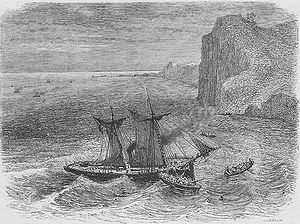USRC Ashuelot

Takao, formerly Ashuelot, in the process of being abandoned during the Battle of Miyako Bay, 1869
|
|
| History | |
|---|---|
| Name: | USRC Ashuelot |
| Namesake: | A river and town in New Hampshire |
| Operator: | United States Revenue Cutter Service |
| Builder: | John Englis |
| Cost: | $103,000 |
| Launched: | 8 Jul 1863 |
| Commissioned: | 1864 |
| Decommissioned: | 30 Apr 1867 |
| In service: |
|
| Fate: | Scuttled (by burning) during Battle of Miyako Bay, Japan, 1869 |
| General characteristics | |
| Class and type: | Pawtuxet-class cutter |
| Displacement: | 350 tons |
| Length: | 130 ft (40 m) |
| Beam: | 26 ft 6 in (8.08 m) |
| Draft: | 11 ft (3.4 m) |
| Depth of hold: | 11 ft (3.4 m) |
| Propulsion: | 1 × two-cylinder oscillating steam engine; single 8 ft (2.4 m) screw |
| Speed: | About 12 knots |
| Complement: | 7 officers, 34 enlisted |
| Armament: | |
USRC Ashuelot was a Pawtuxet-class screw steam revenue cutter built for the United States Revenue Marine during the American Civil War.
Ashuelot was homeported in Maine and later in Charleston, South Carolina during her brief career with the Revenue Marine. In 1866, she played an important role in the prevention of an armed raid on Canada by the Fenian Brotherhood.
Sold into merchant service in 1867 due to dissatisfaction with her machinery, Ashuelot later voyaged to Japan, operating under the names Takao and Kaiten No. 2. She was destroyed in the Battle of Miyako Bay in 1869.
Ashuelot was one of six Pawtuxet-class screw schooners ordered by the Treasury Department in 1863 for the United States Revenue Marine. She was built in New York City by John Englis, from whose yard she was launched on 8 July 1863. Englis was later awarded a bronze medal by the American Institute for a model of the vessel, "a trophy valued because of the great competition then existing in that department of American ship-building".
Ashuelot was 130 feet (40 m) long, with a beam of 26 feet 6 inches (8.08 m) and both hold depth and draft of around 11 feet (3.4 m). Like the other ships of her class, her contract called for a hull of oak, locust and white oak, strengthened with diagonal iron bracing. Her two-cylinder oscillating engine, built by New York's Novelty Iron Works, drove a single 8-foot (2.4 m) diameter screw propeller.Ashuelot's speed is unrecorded but was probably similar to the 12 knots achieved by her sister ship USRC Kankakee. She was topsail schooner-rigged for auxiliary sail power.
...
Wikipedia
